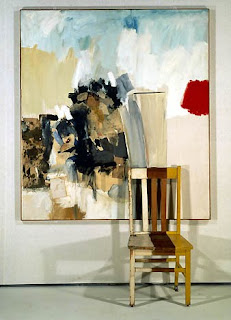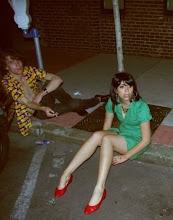Tuesday, December 15, 2009
Sunday, December 13, 2009
Sunday, December 6, 2009
Postmodern Art Ed pt. 2!!
http://handbook.laartsed.org/home/index.ashx
i haven't fully scoped this, but it is the handbook for k-12 professional development planners.
i haven't fully scoped this, but it is the handbook for k-12 professional development planners.
Postmodern approaches in Art Education?!!
Don't worry kids, sometime soon the world will make sense.
http://www.jstor.org/stable/1320508
This is such a good jumping point at making my hypothesis valid for experiment. However, I have yet to overcome the obstacles that arise with elementary education with putting more on their plate than can be ingested, and the article admits the extra time, work, and cooperation that Postmodern Art Education demands. How does one avoid pitfalls with time restraints? it still seems clear that students can grab onto modernist understandings of art, but it often slips away with puberty.
for reference, the following information is a comprehensive description of Discipline-Based Arts Education - a notion which is referred to often in the article.
The Discipline Based Art Education approach to curriculum combines experiences
from four disciplines in the study of art:
Art Production Art Criticism Art History Aesthetics
Discipline Based Art Education merges the disciplines instead of teaching concepts
from each discipline separately. There would not be a "Unit in Art History" or a "Unit
in Aesthetics".
Art Production is the making of art, and the various components of making art,
such as use of tools, manipulation of media, form and expression.
Art Criticism is the examination and discussion of style, formal principals of design
and elements of art (in terms of color, line, perspective, texture, and shading).
Art History is not just "who made what when," but is the history of objects and the
history of people through art. Works of art provide a unique documentation of
cultural changes throughout history. Studying historical works not only gives us
insights into the past, but can also provide valuable insights and information about
the present.
Aesthetics is the philosophy of art. Philosophical questions about art seem to be
unanswerable. What is art? What is good art? What is beauty? It is important in the
study of art that students engage their brains, think about what they are doing,
learning, and feeling about their art and the art of others. In studying art through
aesthetic questioning, the answer is not important. The act of working through the
puzzle provided by the question is extremely important.
http://www.jstor.org/stable/1320508
This is such a good jumping point at making my hypothesis valid for experiment. However, I have yet to overcome the obstacles that arise with elementary education with putting more on their plate than can be ingested, and the article admits the extra time, work, and cooperation that Postmodern Art Education demands. How does one avoid pitfalls with time restraints? it still seems clear that students can grab onto modernist understandings of art, but it often slips away with puberty.
for reference, the following information is a comprehensive description of Discipline-Based Arts Education - a notion which is referred to often in the article.
The Discipline Based Art Education approach to curriculum combines experiences
from four disciplines in the study of art:
Art Production Art Criticism Art History Aesthetics
Discipline Based Art Education merges the disciplines instead of teaching concepts
from each discipline separately. There would not be a "Unit in Art History" or a "Unit
in Aesthetics".
Art Production is the making of art, and the various components of making art,
such as use of tools, manipulation of media, form and expression.
Art Criticism is the examination and discussion of style, formal principals of design
and elements of art (in terms of color, line, perspective, texture, and shading).
Art History is not just "who made what when," but is the history of objects and the
history of people through art. Works of art provide a unique documentation of
cultural changes throughout history. Studying historical works not only gives us
insights into the past, but can also provide valuable insights and information about
the present.
Aesthetics is the philosophy of art. Philosophical questions about art seem to be
unanswerable. What is art? What is good art? What is beauty? It is important in the
study of art that students engage their brains, think about what they are doing,
learning, and feeling about their art and the art of others. In studying art through
aesthetic questioning, the answer is not important. The act of working through the
puzzle provided by the question is extremely important.
Wednesday, December 2, 2009
Oh, Charlotte.
Faulkner has a short story called Wild Palms that describes Faulkner's take of the emerging modern woman. And she is finally all woman. Her name is Charlotte Rittenmeyer.
This is her deal.
This character convinces me that if I were to live in any other time period that I would be a tragedy because how she loves is how I think that I love.
Charlotte, in 1930's Chicago, can only die to put to rest her destroyed love. Manifested in her unwanted pregnancy.
(And then, at the end of Modernism, late 1960's New York, Valarie Solanas shot Andy Warhol. So that is my other proof.)
I don't know. I still feel like I could slip past my time.
I highly recommend a reading of Wild Palms. Often, it is included a half of a novel called If I Forget Thee, Jerusalum. The entire book has another great story called "The Old Man". In total, the page length is around 3 hundred the Wild Palms is just shy of 130, max.
This is her deal.
This character convinces me that if I were to live in any other time period that I would be a tragedy because how she loves is how I think that I love.
Charlotte, in 1930's Chicago, can only die to put to rest her destroyed love. Manifested in her unwanted pregnancy.
(And then, at the end of Modernism, late 1960's New York, Valarie Solanas shot Andy Warhol. So that is my other proof.)
I don't know. I still feel like I could slip past my time.
I highly recommend a reading of Wild Palms. Often, it is included a half of a novel called If I Forget Thee, Jerusalum. The entire book has another great story called "The Old Man". In total, the page length is around 3 hundred the Wild Palms is just shy of 130, max.
Subscribe to:
Comments (Atom)








